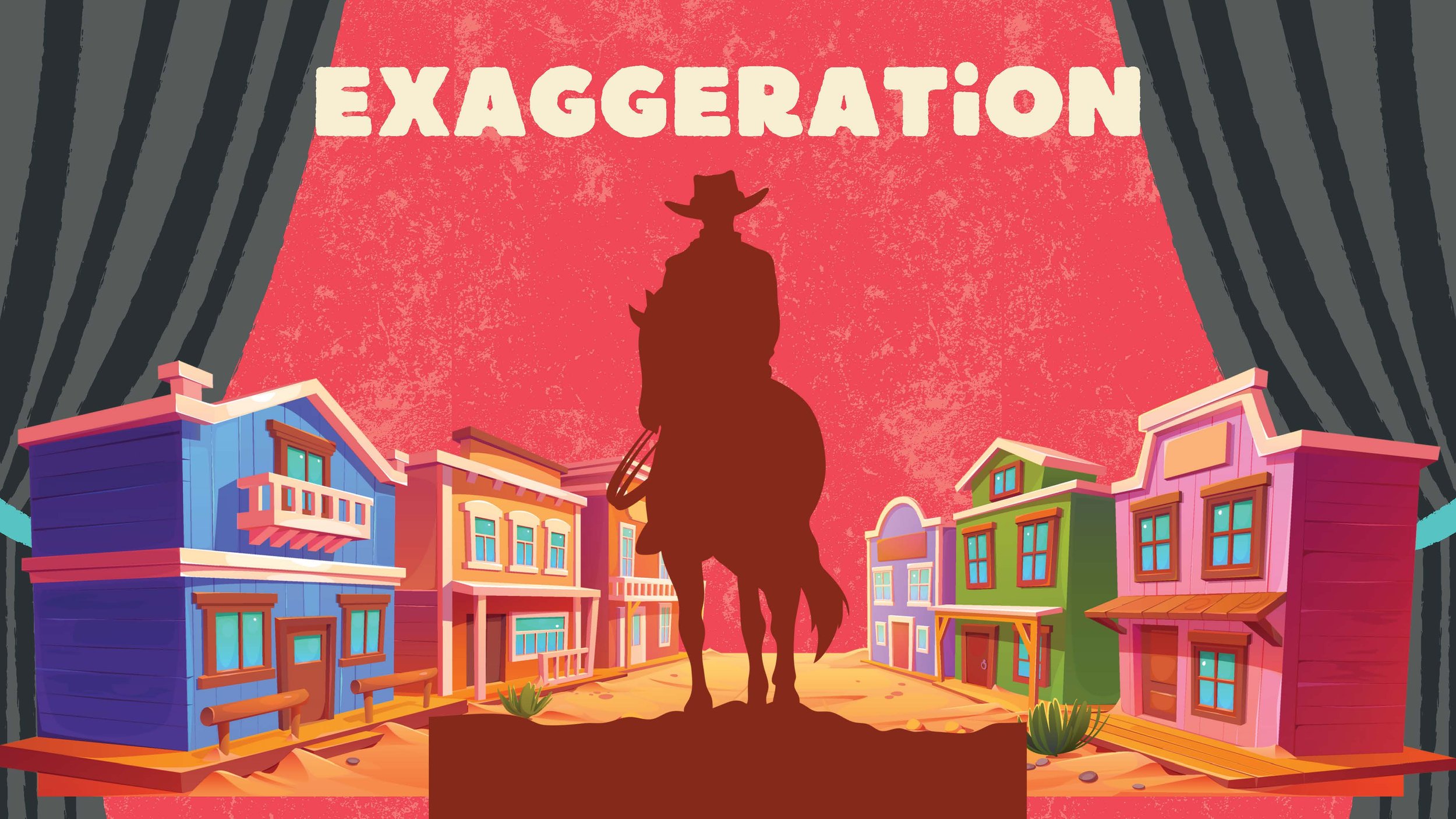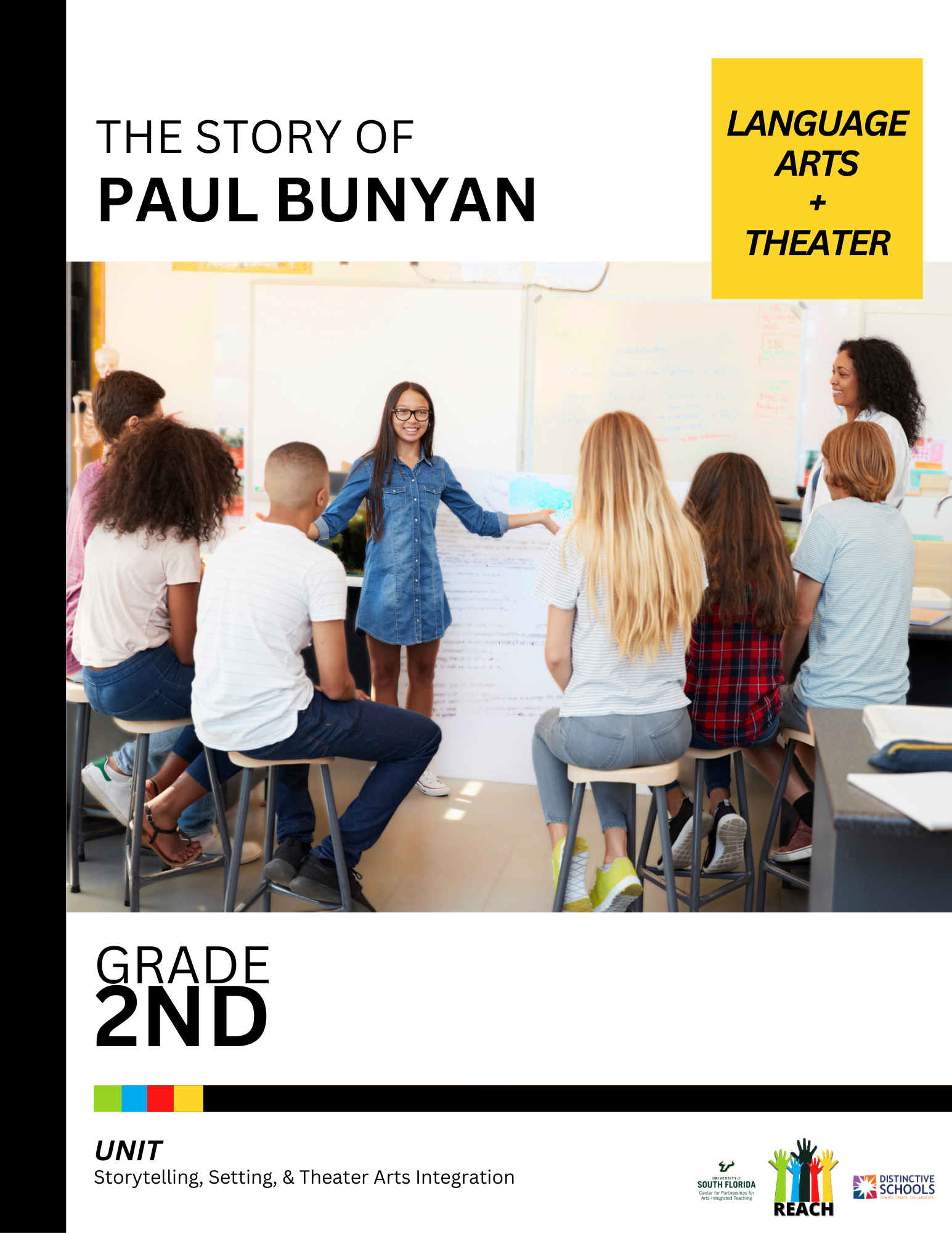Storytelling, Setting, and Theater Arts Integration
The Story of Paul Bunyan
2nd Grade • English Language Arts (ELA) & Theater
Lesson Overview: This comprehensive second-grade lesson plan integrates theater arts with language arts through the story of Paul Bunyan, using creative movement and dramatic play to teach the characteristics of tall tales and story elements. Through carefully structured learning activities, students explore exaggeration techniques using their voices, bodies, and imagination, transitioning from everyday movements to larger-than-life expressions that characterize tall tales. The teacher and teaching artist develop instructional techniques that foster student participation and engagement.
Learning Objectives | Students Will:
Showcase the sneak previews to an audience.
Reflect on the learning journey and the skills developed throughout the project.
Celebrate the achievements and progress made by all students.
Lesson Process: In this focused lesson, students deepen their grasp of essential storytelling elements by examining how setting, characters, and plot work together to craft engaging narratives. They apply this knowledge directly as they write and refine their sneak preview scripts, with special attention to creating captivating introductions. Through guided practice, students develop their narrative delivery skills, learning to use vocal techniques like tone, pacing, and projection to bring their stories to life. This integrated approach helps students become both skilled writers and confident storytellers.
Time Required:
60 minutes
Materials List:
Copies of script drafts
Open space for vocal exercises
Slides with visuals
Assessment :
Assessment includes observation of student participation and engagement, and a partial Story Spine activity.
The content teacher will use Partial Story Spine (Fairy Tale or Tall Tall) and observation of participation.
The teaching artist will use Observation: observe students' participation and engagement in all activities noticing how they construct their understanding.
Alternative system of assessment is developed to measure not only subject matter achievement and arts learning’.



Lesson
Activities & Instructions
The Activities & Instructions section provides a structured sequence of learning experiences, guiding educators through engaging, interactive lessons.
Lesson Activities
-
Greet students and introduce themselves.
Explain the role of a teaching artist and the purpose of the residency.
Highlight that actors are storytellers who use tools like voice, body, and imagination to bring stories to life.
Briefly introduce the concept of Tall Tales and their exaggerated nature.
-
Lead the Actor’s Tools Warm-up focusing on voice, body, and imagination.
Voice: Engage in vocal exercises to explore different sounds.
Body: Perform simple movements to warm up the body.
Imagination: Conduct quick imagination exercises, such as pretending to be different animals or objects.
-
Expand on the concept of Tall Tales, providing examples of exaggeration.
Engage students' imagination in identifying exaggerated elements.
Use actor's tools by asking students to "show me" examples of exaggerated actions or expressions they might find in Tall Tales using their voice, body, and imagination.
-
Review specific vocabulary. Read "Casey Jones" aloud to the class, focusing on the plot progression.
Classroom Teacher Activities:
Go over specific vocabulary related to the story.
Read "Paul Bunyan" to the class.
Pause occasionally to explain vocabulary and check for understanding.
Teaching Artist Activities:
Support the teacher by highlighting key moments in the story.
Encourage students to visualize the story as it’s being read (Think like an actor).
Prompt students to use their imagination to picture the exaggerated scenes described.
-
Teaching Artist Activities:
Facilitate the discussion by prompting students with questions using the "who, what, where, when, why" framework. ○ Setting: Ask students to use their imagination and "show me" where and when the story takes place by using their body and space in the room.
Characters: Have students "show me" who the characters are by using body language (posture, gesture and facial expressions) to represent them.
Plot: Ask students to identify and show "what happens" in the story and explore "why" the characters behave the way they do, focusing on using their voice, body, and imagination.
Encourage students to express the story elements physically and vocally, using their actor's tools to bring the story to life.
-
Introduction to “Yes, Let’s!”- Explain the rules of the game. Start by having students act and suggest regular everyday actions. Encourage students to perform these actions with their normal body language focusing on how they would do these actions in real life.
Transition to Exaggerated Actions connected to “Paul Bunyan”.- Encourage students to exaggerate their actions and emotions.
Reflection- Ask students how it felt to perform both regular and exaggerated actions and how it changes the way a story is told.
-
Review key points- reinforcing the importance of exaggeration in Tall Tales and in acting.
Guide students to write or draw an exit ticket prompt making acting and vocabulary connections.
NATIONAL CORE ARTS STANDARDS
-
Anchor Standard 1
Generate and conceptualize artistic ideas and work.Anchor Standard 2
Organize and develop artistic ideas and work. -
Anchor Standard 5
Develop and refine artistic work for presentation.Anchor Standard 6
Convey meaning through the presentation of artistic work.
Success Criteria
Students successfully present their sneak previews to an audience, demonstrating clarity, expression, and confidence.
Students engage in reflective discussions, articulating what they learned and how they grew during the project.
Students participate in the celebration of their and their peers' achievements, recognizing their efforts and progress.
Key Themes & Ideas:
Arts Integration: The lesson prominently integrates theater techniques into a language arts curriculum to enhance student learning and engagement. The teaching artist plays a key role in leading theater-based activities. The lesson incorporates activities like vocal exercises, identifying story elements, and exaggerated acting to enhance comprehension and expression.
Plot Structure and Story Elements: Actor's Tools (Voice, Body, Imagination): The lesson emphasizes the use of voice, body, and imagination in understanding and acting out the story. The warm-up activities focus on these tools.
Connections and Team Building: Students make connections between the tall tales and their backgrounds and/or experiences.They learn to identify the basic elements of a story: characters, setting, and plot. The lesson guides students in discussing and representing these elements from the "Paul Bunyan" story. They are prompted to think about "who" the characters are, "where" and "when" the story takes place, and "what happens" in the story. They use their bodies, voices, and imaginations to express these elements, solidifying their understanding.
Accessibility: The lesson thoughtfully incorporates multiple learning modalities, with Spanish translation support and visual aids ensuring all students can access and engage with the material.
Collaborative Teaching: This comprehensive lesson plan integrates theater and language arts to teach second-grade students about story structure and plot progression through the tale of Casey Jones. The plan combines traditional classroom instruction with interactive theater exercises, including a "What Happens Next?" improv game, to help students understand beginning, middle, and end story elements while accommodating students’ learning needs through visual aids, Spanish translation, and differentiated support. The collaborative approach between the classroom teacher and teaching artist creates multiple entry points for learning, incorporating physical movement, oral storytelling, and creative expression to deepen student engagement and understanding.
– REACH –
Thank you to our Educators, Artists, and Collaborators.
School: Rowlett Elementary
Teacher: Theresa Kauffman
Teaching Artist: Maria Schaedler-Luera
Arts Organization: Atomica Arts
-
Resource 1: link

